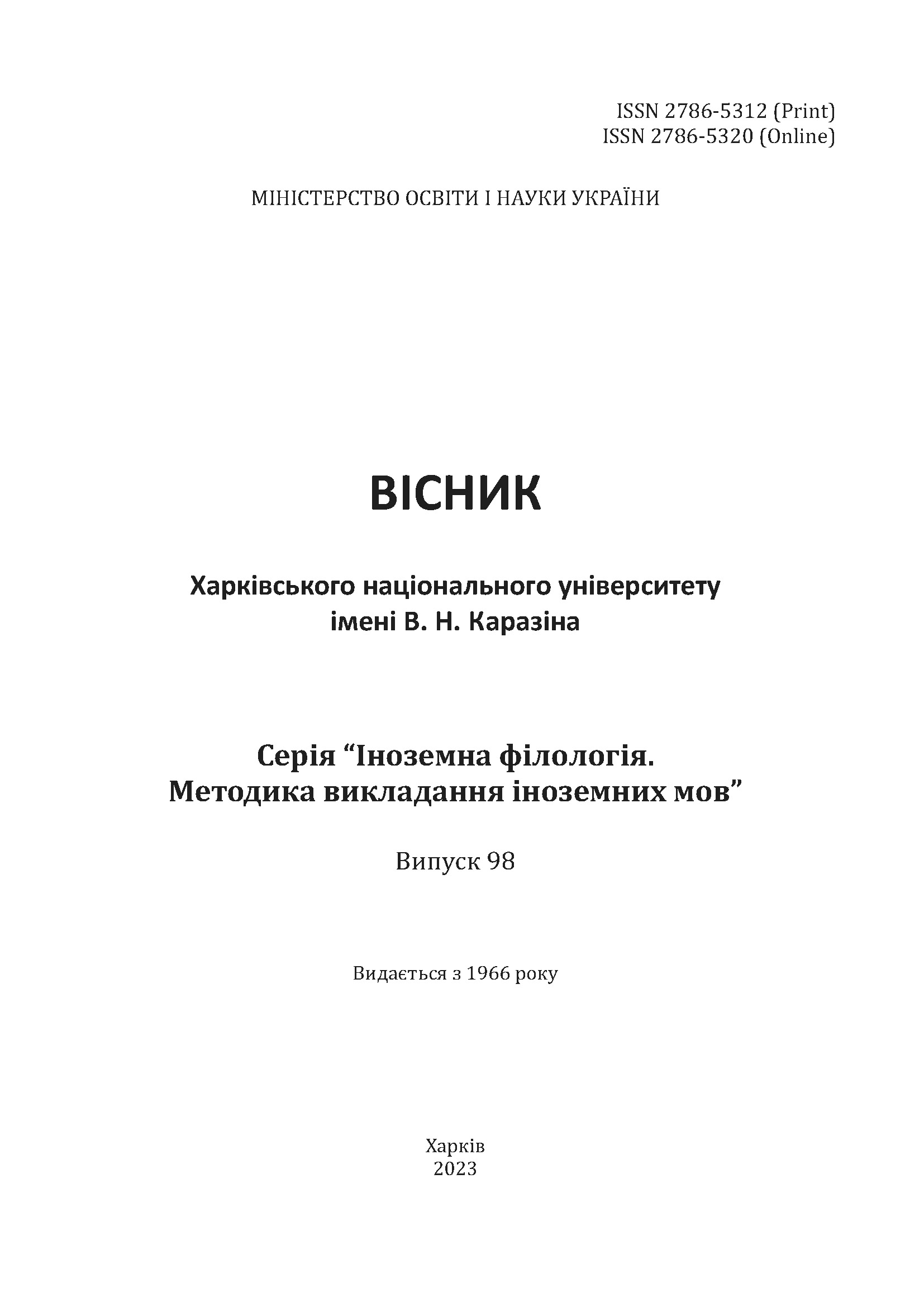Conceptual integration as a mechanism of formation and intertextual functioning of the “blood, sweat and tears” quotation
Abstract
The article researches into the conceptually underpinned formation and intertextual instantiation of the quotation “blood, sweat and tears”, which has a high reference potential for English-speaking cultures. Conceptual integration processes are key for the emergence of the metaphtonymic meaning of the quotation and its compositional stability, transformation potential and models of intertextual instantiation. The metaphtonymic meaning of this quotation is shaped as a result of conceptual integration of three input spaces, represented by the metaphtonymies BLOOD (for ‘human sacrifice’), SWEAT (for ‘human toil’) and TEARS (for ‘human suffering’), which blend to generate the meaning “backbreaking painful sacrifice”. The specific metaphtonymy underpinning the emergence of the “blood, sweat and tears” quote guides its intertextual instantiation as a result of the processes of conceptual integration following the metaphoric “container” model, verbalized with the verbs “to put”/”to pour”. The quote under analysis is predominantly used in publicistic texts, as such context provides their authors with an opportunity to create a positive association with the personality of Winston Churchill, who used it in his famous speech as a model British Prime-Minister figure and thus enabled its further intertextual functioning. Intertextual instantiation of the “blood, sweat and tears” quotation can be modelled as a multi-scope blend generating multi-dimensional meanings. The adopted research perspective unlocks the explanatory potential of the theory of intertextuality due to the application of the theory of conceptual blending to the processes of formation and intertextual instantiation of the quotation as a referenced phenomenon.
Downloads
References
Bieliekhova, L. I. (2002). Obraznyi prostir amerykanskoi poezii: linhvokohnitychnyi aspekt. (Diss. dokt. filol. nauk) [Image Space of American Poetry: the Linguistic and Cognitive Aspect (Doctor of Science in Philology Thesis)]. Kyivskyi natsionalnyi linhvistychnyi universytet, Kyiv. (in Ukrainian)
Chornovol-Tkachenko, R. S. (2007). Pretsedentnyi tekst yak osnova linhvostylistychnoi realizatsii katehorii intertekstualno¬sti (na materiali kazok Liuisa Kerrola) (Avtoreferat kandydatskoi dysertatsii) [Referenced Text as the Basis for Linguostylistic Instantiation of the Category of Intertextuality (Philology PhD thesis synopsis)]. Kharkivskyi natsionalnyi universytet imeni V. N. Karazina, Kharkiv. (in Ukrainian)
Churchill W. Blood, toil, tears and sweat. Retrieved from: https://winstonchurchill.org/resources/speeches/1940-the-finest-hour/blood-toil-tears-sweat/
Collins Dictionary. Retrieved from: https://www.collinsdictionary.com
Coulson, S., & Oakley, T. (2005). Blending and coded meaning: Literal and figurative meaning in cognitive semantics. Journal of Pragmatics, 37, 1510–1536.
Coulson, S., & Oakley, T. (2001). Blending basics. Cognitive Linguistics, 11(3–4), 175–196.
Fauconnier, G., & Turner, M. (2002). The Way We Think: Conceptual Blendings and the Mind’s Hidden Complexities. New York: Basic Books.
Goossens, L. (1990). Metaphtonymy: the interaction of metaphor and metonymy in expressions for linguistic action. Cognitive Linguistics, 1–3, 323−340.
Kachur, I. V. (2020). Metonimiia u publitsystychnomu dyskursi: linhvokohnitytyvnyi i dyskursyvnyi aspekty (Diss. kand. filol. nauk) [Metonymy in Publicistic Discourse: Linguistic, Cultural and Dircursive Aspects (Philology PhD thesis)]. Kyivskyi natsionalnyi linhvistychnyi universytet – Zaporizkyi natsionalnyi universytet, Kyiv–Zaporizhzhia. (in Ukrainian)
Lakoff, G. (2003). Metaphors We Live By. Chicago: University of Chicago Press.
Meaning and Origin of the Expression: blood, sweat and tears. Retrieved from: https://www.phrases.org.uk/meanings/blood-sweat-and-tears.html#:~:text=The%20expression%20’blood%2C%20sweat%20and,to%20come%20in%20fighting%20WWII
Matuzkova, O. P. (2020). Linhvokultura yak synerhiia movy, kultury ta svidomosti [Linguistic Culture as Synergy of Language, Culture and Mind] Sotsiolinhvistyka. Linhvokulturolohiia. Kohnityvna linhvistyka [Sociolinguistics. Linguistic Culturology. Cognitive Linguistics], 27, 160−172. (in Ukrainian)
Morozova, O. I. (2017). Monomodal and multimodal instantiations of conceptual metaphors of Brexit. LEGE ARTIS Language yesterday, today, tomorrow (Vol. II.), 2, 250–283.
Nefyodova, O. D. (2022). Intertekstualnist na poli medii: ekolinhvistychnyi rakurs [ Intertextuality in Media: Ecolinguistic Perspective]. Visnyk Kharkivskoho natsionalnoho universytetu imeni V.N. Karazina [The journal of V.N. Karazin Kharkiv National University], 96, 23−29 (in Ukrainian)
Onyshchenko N. A. (2009). Pretsedentna osobystist yak chynnyk formuvannia eptonimichnoho fondu [Reference Personality as a Factor in Forming the Etponymic Thesaurus]. Visnyk Kharkivskoho natsionalnoho universytetu imeni V. N. Karazina [The jour¬nal of V.N. Karazin Kharkiv National University], 848, 72–77. (in Ukrainian)
Piegay-Gros, N. (2022). Introduction a l’intertextualité. Armand Colin.
Samokhina, V. O. (2015). Dialektyko-dialohichna sutnist fenomena intertekstualnosti yak polifonii tekstiv [ Dialectics and Dialogue in Intertextuality as Textual Poliphony]. Visnyk Kharkivskoho natsionalnoho universytetu imeni V. N. Karazina [The journal of V.N. Karazin Kharkiv National University], 81, 21–28. (in Ukrainian)
Selivanova O. O. (2006). Suchasna linhvistyka: Terminolohichna entsyklopediia [ Modern Linguistics; Terminological Encyclopaedia]. Poltava: Dovkillia – K Publ. (in Ukrainian)
Vermenych, Ya. V. (2021). Multymodalni metafory z referentom EKOLOHIIa v anhlomovnomu ekolohichnomu kinodyskur¬si. Diss. PhD [Multimodal Metaphors with ECOLOGY Referent in English Ecological Cinema Discourse (Philology PhD thesis)], Kharkivskyi natsionalnyi universytet imeni V.N. Karazina, Kharkiv, (in Ukrainian)
Zahnitko, A. P. (2017). Linhvokulturolohiia: navchalnyi posibnyk. [Linguistic Culture Studies: tutorial]. Vinnytsia : DonNU imeni Vasylia Stusa Publ. (in Ukrainian)
ILLUSTRATIVE MATERIAL
‘Blood, sweat and tears’: Ava Duvernay shares the back story to her history-making movie. Retrieved from: https://www.news24.com/life/arts-and-entertainment/film/blood-sweat-and-tears-ava-duvernay-shares-the-back-story-to-her-history-making-movie-20230907
Bridge / Agency Changes Stance on Structures. Retrieved from: https://books.google.com.ua/books?id=gVFSAAAAIBAJ&p-g=PA7&dq=put+blood,+sweat+and+tears&article_id=3895,4386451&hl=ru&sa=X&ved=2ahUKEwj9hK7B8dv1AhWN_7sIH¬dc1BpU4HhDoAXoECAIQAg#v=onepage&q=put%20blood%2C%20sweat%20and%20tears&f=false.
Congressional Record: Proceedings and Debates of the 84th Congress. U.S. Congress, 1955. Retrieved from: https://books.goo-gle.com.ua/books?id=Tipoi0h56nYC&pg=PA2678&dq=blood,+sweat+and+tears&hl=ru&sa=X&ved=2ahUKEwjA_o6H49v1Ah¬Vpg_0HHeksCjMQ6AF6BAgFEAI#v=onepage&q=blood%2C%20sweat%20and%20tears&f=false.
Wildfire Destroys Family Home. Retrieved from: https://www.cbc.ca/radio/thecurrent/wildfire-destroys-family-home-squi¬lax-bc-1.6943881

This work is licensed under a Creative Commons Attribution 4.0 International License.




